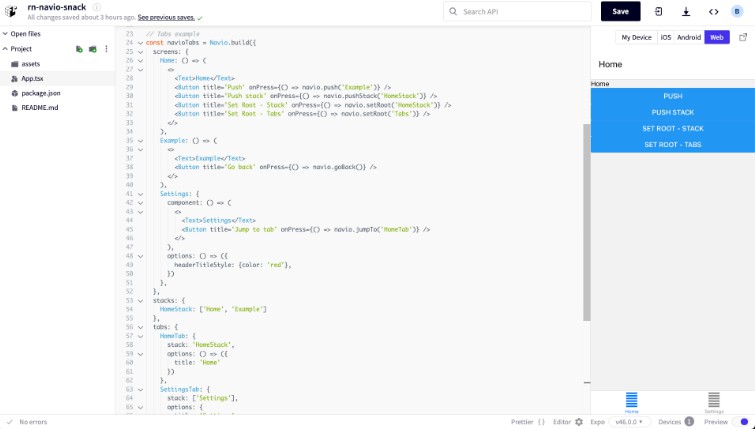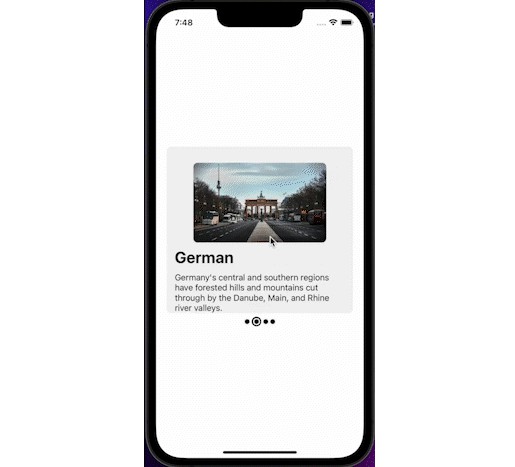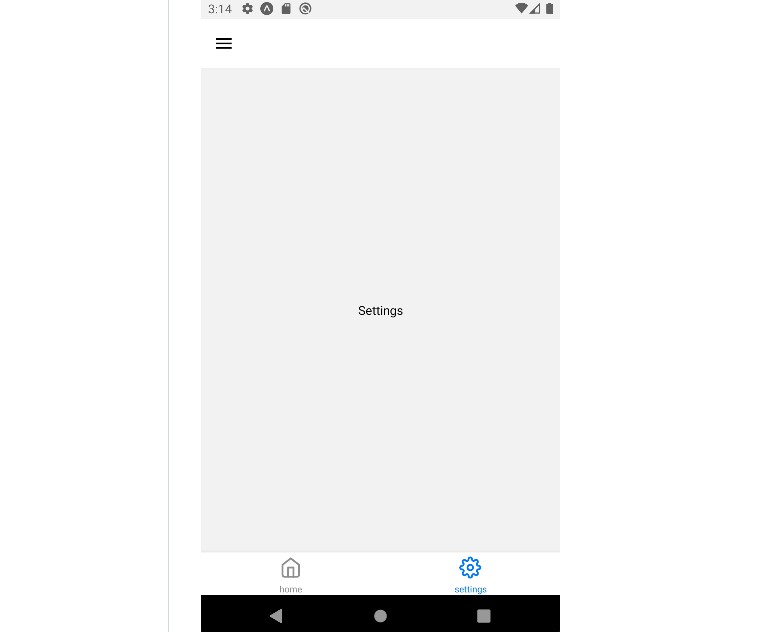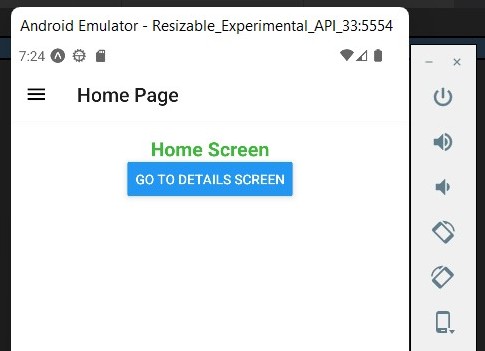? Navio
Navio is a tiny library (wrapper) built on top of React Navigation that makes it easy to build an app’s layout (navigation structure) in one place and use benefits of types predictability across the app. Predictability of route names while building app’s layout and using navigation methods (e.g. push, jumpTo) leads to better DX, less mistakes and faster development process. And yes, no more messing with <NavigationContainer>, <Tabs.Navigator>s and <Stack.Screen>s!
☣️ This is an experimental library and may have breaking changes in the future.
Quickstart
yarn add rn-navio
React Navigation dependencies
As Navio is built on top of React Navigation, you will need to have the following libraries installed:
yarn add @react-navigation/native @react-navigation/native-stack @react-navigation/bottom-tabs
For more information, please check the installation steps.
Playground
You can bootstrap (from expo-starter) a new project with Expo and Navio:
npx cli-rn new app
Or play with the library in the Expo Snack:
Examples
- 2 screens
Show code
import {Navio} from 'rn-navio';
const navio = Navio.build({
screens: {
Home: () => (
<>
<Text>Home</Text>
<Button title="Push" onPress={() => navio.push('Example')} />
</>
),
Example: () => (
<>
<Text>Example</Text>
<Button title="Go back" onPress={() => navio.goBack()} />
</>
),
},
});
export default () => <navio.Root />;
- Tabs
Show code
import {Navio} from 'rn-navio';
const navioTabs = Navio.build({
screens: {
Home: () => (
<>
<Text>Home</Text>
<Button title="Push" onPress={() => navio.push('Example')} />
<Button title="Push stack" onPress={() => navio.pushStack('HomeStack')} />
<Button title="Set Root - Stack" onPress={() => navio.setRoot('HomeStack')} />
<Button title="Set Root - Tabs" onPress={() => navio.setRoot('Tabs')} />
</>
),
Example: () => (
<>
<Text>Example</Text>
<Button title="Go back" onPress={() => navio.goBack()} />
</>
),
Settings: {
component: () => (
<>
<Text>Settings</Text>
<Button title="Jump to tab" onPress={() => navio.jumpTo('HomeTab')} />
</>
),
options: () => ({
headerTitleStyle: {color: 'red'},
}),
},
},
stacks: {
HomeStack: ['Home', 'Example'],
},
tabs: {
HomeTab: {
stack: 'HomeStack',
options: () => ({
title: 'Home',
}),
},
SettingsTab: {
stack: ['Settings'],
options: {
title: 'Settings',
},
},
},
options: {
tab: {
// default tab's options
headerShown: false,
},
},
});
export default () => <navio.Root />;
- Advanced example with all available props can be found @ expo-starter/src/screens/index.tsx
Usage
Layout
Navio’s layout contains of one required field screens and optional fields such as stacks, tabs, modals, root, hooks and options. Stacks are built with screens‘ names. Tabs and modals are built with stacks‘ and screens names.
type Layout<Screens, Stacks, Tabs, Modals, RootName> = {
/**
* Screens of the app. Navigate to by using `navio.push('...')` method.
*/
screens: Screens;
/**
* Stacks of the app. Navigate to by using `navio.pushStack('...Stack')` method. Good to use if you want to hide tabs on the specific screens.
*/
stacks?: Stacks;
/**
* Tabs of the app. Navigate to by using `navio.jumpTo('...Tab')` method.
*/
tabs?: Tabs;
/**
* Modals of the app. Navigate to by using `navio.show('...Modal')` method.
*/
modals?: Modals;
/**
* Root name to start the app with. Possible values `'Tabs' | any of stack`.
*/
root?: RootName;
/**
* List of hooks that will be run on each generated stack or tab navigators. Useful for dark mode or language change.
*/
hooks?: Function[];
/**
* Default options to be applied per each stack's screens or tab generated within the app layout.
*/
options?: {
stack?: BaseOptions<NativeStackNavigationOptions>;
tab?: BaseOptions<BottomTabNavigationOptions>;
};
};
Root component
Navio generates root component for the app after the layout is built. It can be used to directly pass it to registerRootComponent() or to wrap with extra providers or add more logic before the app’s start up.
const navio = Navio.build({...});
export default () => <navio.Root />
Navigation
Once the app’s layout is built, Navio instance can be used to perform navigation actions in the screens. All available methods are listed below:
interface Actions = {
/**
* `push(...)` is used to navigate to a new screen in the stack.
*/
push(name: ScreenName, props?: Props): void;
/**
* `pushStack(...)` is used to navigate to a new stack. It will "hide" tabs.
*/
pushStack(name: StackName): void;
/**
* `goBack()` is used to navigate back in the stack.
*/
goBack(): void;
/**
* `pop(...)` is used to navigate to a previous screen in the stack.
*/
pop(count?: number): void;
/**
* `popToPop()` is used to navigate to the first screen in the stack, dismissing all others.
*/
popToTop(): void;
/**
* `show(...)` is used to show a modal.
*/
show(name: ModalName): void;
/**
* `jumpTo(...)` is used to change the current tab.
*/
jumpTo(name: TabName): void;
/**
* `setRoot(...)` is used to set a new root of the app. It can be used to switch Auth and App stacks.
*/
setRoot(name: 'Tabs' | StackName): void;
};
Enhancements
There are still some things I would like to add to the library:
- Test on more use cases.
- Make it universal by adding RNN (similar to rnn-screens).
- Pass props to stack and tabs navigators.
- Types for props.
Feel free to open an issue for any suggestions.
License
This project is MIT licensed







